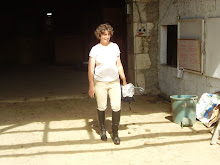from a young American who is in France as a language assistant. She is going to give private lessons to an adult who needs English for his work. She asked:
Would you mind giving me a few
pointers for his first lesson? So what do you think? How should I start? Any suggestions would be
greatly appreciated!!
Kelsey
Kelsey
My reply:
I have similar students. I'm attaching stories that I did with them.
If he hasn't studied since 5ème, you should consider him a beginner.
I would start with has/ wants/
gives as structures. These are high frequency verbs that will come
into almost all your following lessons.
Do you understand about circling? I wish you were closer to me so I
could demonstrate. But there are videos of Ben Slavic in class, which can
help you to get an idea, too. And there are several blogs which help a
lot. Ben Slavic has lots of resources that are free. It's too bad
you didn't get his book. It’s worth every penny because it takes you
through the whole process a step at a time. I probably should ask him for a
commission, but he has a wonderful knack for asking important questions and
coming up with well-expressed, comprehensible answers.
Your student may want to say has got instead
of has. All the French manuals
teach has got. I think this is
unfortunate because it leads to a lot of confusion and mistakes, so I steer
away from that and teach has - doesn't
have - do you have? so that the structure will work with all the other
verbs they learn, whereas has got is
a dead end and it’s so high frequency that they are sure to pick it up later
anyway.
I'm also attaching a poster with the question words which I give to my
students and point to throughout the lesson. The principle is quite simple. You
present has/ have and explain that
they mean a/ai, as,avons, avez, ont. This
is a good time to explain that English is simpler than French and it only gets
complicated when you try to compare the two grammars. Then you ask him if
he has....whatever. Ideally a word he already knows or a cognate or a
brand name. An I-pad? a guitar? Whatever he might have and
that interests him. You can fish around and try several things until you
see his eyes light up and you know you're talking about something that
interests him. You talk about who has it and who doesn't have it and you
circle, circle, circle. You can work in colors and numbers and sizes at
this point. I have two big white cats and you have one little black cat,
etc. You try to speak English all the time, but you also want him to understand
everything you say. If you see a blank look, you "sandwich" the part
he didn't understand. That is you say it in English, then in French and
then in English again, so he's hearing the translation between two repetitions
of the English word. After a couple times, the blank look will go away.
Hopefully.
Once you've decided that he has/doesn't
have something, you talk about who wants it. and you circle the structure wants in the same way. If he doesn't have something he wants, you've got the beginning of a
story. Then you move on to gives.
You can see in the Stories document what a group of twelve year old boys
(in 5ème) did with this. It usually takes about an hour to build up a
story. At any point if you can work in some genuine conversation that is
100% comprehensible, you'll both be well on your way to success. The best TPRS teachers "just chat" with their students.
For the next hour you can either type up the story you made together, or a
different one that uses the same vocabulary. You read the story a sentence at a
time.
I ask beginners to translate the sentence, which helps me verify
that they are understanding and understanding correctly. I know that some
teachers scorn translation because it has been much abused. In the past
that's all traditional teachers did in class and I'm old enough to remember
such classes. In my junior year I was taking both Latin and Spanish from
the same teacher. In both classes we memorized lists of vocabulary,
translated a text and answered questions about the text. In short she
taught Spanish with the same method she used to teach a dead language.
What is different with TPRS
is that you use translation to be sure that the student understands, and I find
that it helps to clarify a lot of misunderstandings. Without translation,
students will take a long time to distinguish between looks at / sees,
listens / hears, etc.
But we only translate one
sentence at a time. Then we circle the sentence. One sentence can produce over fifteen questions.
Be careful not to ask for complete sentences when he answers. A one
word answer shows that he understands the question. Otherwise he just
repeats the original sentence back to you over and over again. Which doesn’t show that he understands and is
“chiant” as one student told me.
(translation = f-king boring)
Basically, that's a TPRS lesson. Step one is presenting the three
structures, Step two is asking personalized questions using the structures and
moving on into a story. Step three is the reading. For
"homework" I make up crossword puzzles using the vocabulary, so they
go back and reread the story to find the words that will fit into the puzzle.
I give adults homework because otherwise they may not do anything with
English until the next lesson. But homework should always be getting them
to listen to something or to read something, never output (writing).
I hope this helps. Good luck!

No comments:
Post a Comment